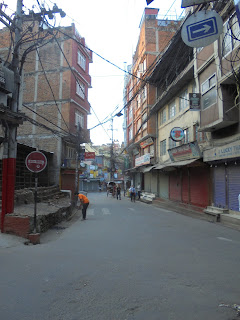Getting a good nights sleep might not be a thing that comes easy. OK, so it was a Saturday night and just about everywhere on the planet considers this to be party night! Not sure exactly where the disco and live music venues are, but based on the sound level, I'd say directly under by room. The strange thing is that in the cold light of the following morning, I could not find a single shred of evidence of their existence.
Waking at 6 am, my body clock holding onto Australian time, I decided to get an early start to the day. The streets were deserted, a truck here and there delivering bulk drinking water and that was about it. After about half an hour I found a hotel cafe putting out it's tables and chairs, with a greeting of nameste I was welcomed in. Breakfast done I decided to walk south along the deserted streets through Thamel and head south to the world famous Durbar Square, said to have been all but destroyed in the recent earthquake.
Navigating your way around Khatmandu is 80% faith, 19% luck and 1% map reading skill. There are no street signs of any sort, in fact, most streets do not have names, the locals just know where they are! To find your way around, you need to just head in the general direction and try to take note of a temple or shrine. Use the guide books descriptions, such as;- "the lump of wood with a mass of coins, is to help cure toothaches" or "the temple decorated with bathroom tiles". This helps a bit, but there are places of worship every 30 meters or so, and they can become a blur. To call them streets is an over statement, generally no more than three meters wide, lane or alleyway would be a better name. Cars and motorbikes are rare, foot traffic being the norm. Once you cross Chhetrapati street the feel changes dramatically, gone are the tourist stores and the little shops become more basic and are definitely geared towards locals. Westerns become few and far between and are replaced by porters with bundles piled high on their head and old men carrying every thing from boxes to old wardrobes on their back, with only a headstrap to hold it in place.
Sunday is a school day in Nepal, so soon the streets were full of little children in crisp uniforms emerging from the most humble of doorways. Up a tiny alley I found a stunning little square, in the center is Kathesimbhu Stupa, a Tibetan pilgrimage site dating back to 1650, old women sat in prayer and incense and candles smoked in the morning light. Heading back down the street to the south you emerge at a small square full of temples and shrines, main one being Sikha Narayan. Every available space, including the temple steps was full of street stalls selling everything from fresh food, clothing, electrical goods and shoes, always shoes.
After about an hour of wandering, I came out on the fabled Durbar Square. Before the earthquake it must have been one of the truly great squares of the world. Much of what is left is severely damaged and fenced off. Piles of brick and lumber are all that is left of some of the greatest buildings. In front of each is a forlorn photo of what once was here. The feel of the place is still spectacular and the Nepalese are furiously rebuilding.
After wandering around the square, I decided to explore the forgotten area to the south. If you leave via a little street in the southwest corner, you'll find yourself in an untouched pocket of old Khatmandu. It's full of winding, slightly hilly streets, no traffic, not another westener in sight and lots of fantastic street life. Highlight is Ta Bahal, a square down a tiny alley that hemmed by ancient houses on every side, apart from a man walking an angry dog and a wizened old woman, I had it to myself.
Pictures of Ta Bahal
































No comments:
Post a Comment